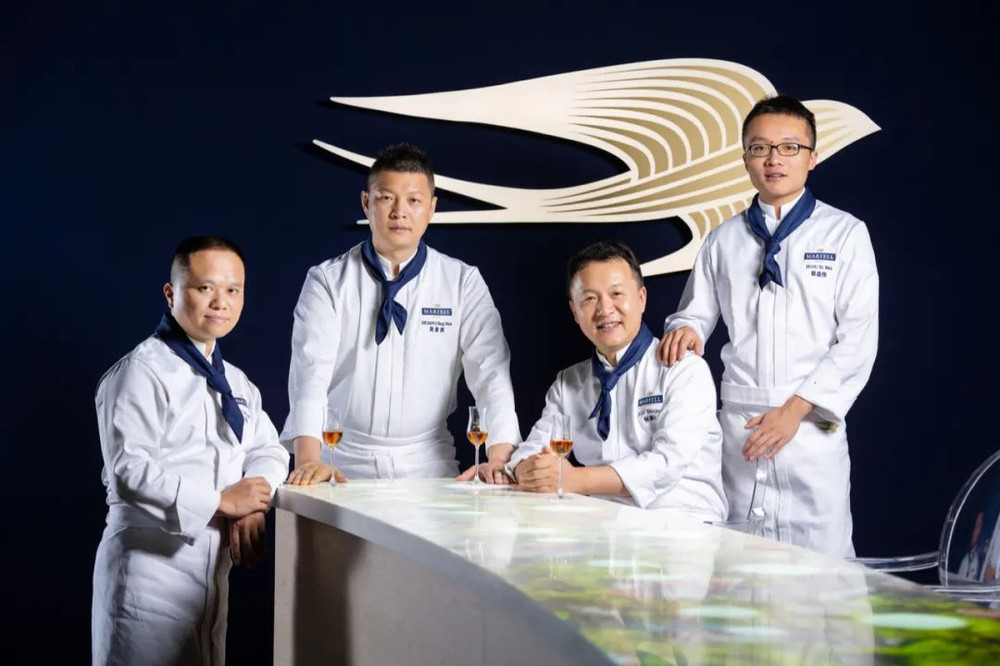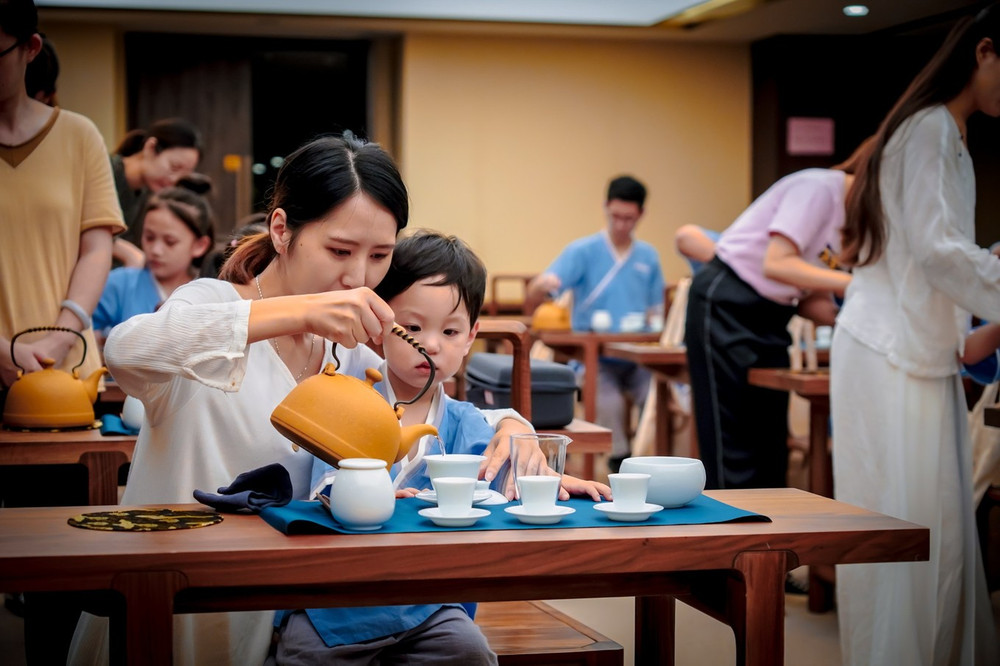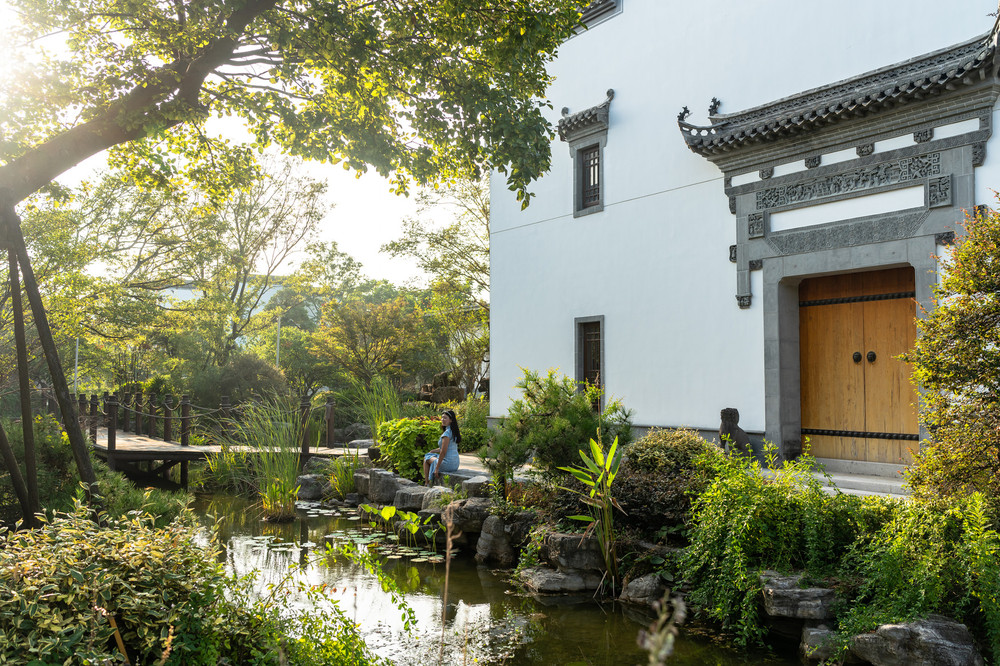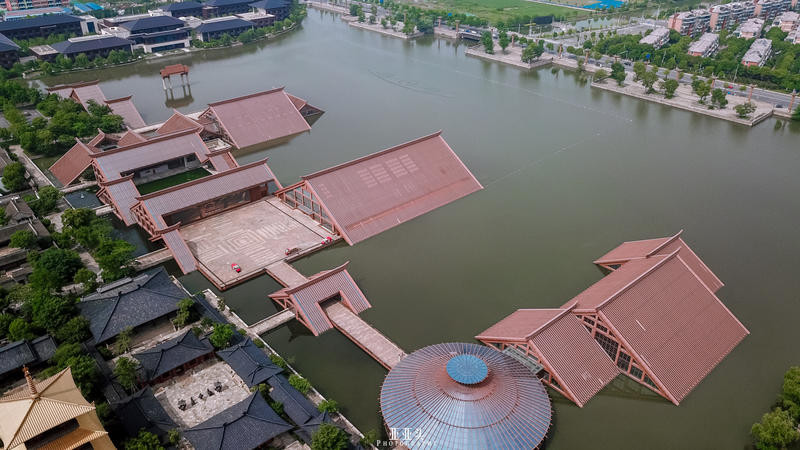Play Method: The food author visited these places: Huangpu River, Shanghai. Published on September 25, 2020, 14:06. [Wine’s Color] After watching a great movie, there is always some astonishment like ‘not knowing the passage of time in the mountains’. And coincidentally, it’s both wine and delicious food, a mutual agreement. Then, I am definitely indulged. By the Huangpu River at night, through the amber liquor of Martell, such a tender night. I sigh that the greediest way to pass the leisure time is nothing more than watching a wonderful movie with eyes, ears, nose, throat, voice and intention. One of the best ways of contemporary seclusion is to let movies be lovers.

After the cinemas are unsealed, the selected films are really limited, and there are almost none that are ‘tasty’. However, last week, due to a fortunate invitation, I had a wonderful movie-watching experience in the Martell Gourmet Theater and tasted four flavors and lights searched by famous chefs. The cross-border adventures of the chefs, modulating delicious flavors that cross mountains and seas in the sea of knives and pans, make people’s emotions surge. Moreover, unexpectedly, I can also really taste it on the spot.
The sea breeze of hometown blows from the marketplace to the city, from the scene of fishermen singing in the evening to modern Shanghai. Chaoshan cuisine has a place in my heart. I once tasted more than thirty meals in three days with foodie friends in Chaoshan. The flavors of walking through the streets and alleys are all worth lingering. Chaoshan cuisine emphasizes the ultimate beauty and freshness of ingredients. The control of the original flavor of ingredients is in place, and the soul in the chef’s spoon is basically formed. Another bit of effort is the finishing touch, which is the cooking heat. The taste difference of every Chaoshan restaurant lies in the control of ‘fire’. It is not easy to cook seafood just right. A Virgo chef will make everyone in the kitchen hate him, but all diners will love him to death.
This time, I tasted two dishes by Chef Du Jianqing in one breath at the Martell Gourmet Theater. It really lives up to the reputation of new-style Chaoshan cuisine. The first dish: Chaoshan fish rice, the most classic choice of Chaoshan cuisine. Chaoshan people ‘take fish as rice’. Every household will eat fish rice. Chef Du Jianqing watched his grandma make fish rice since childhood and was influenced by it. He is familiar with the knack of making fish rice: cooking fish rice requires deep soup and strong fire, enough sea salt water, and sufficient cooking heat. In the boiling sea salt water, the taste of the sea is deeply absorbed by the fish. Then it is placed in a cool and ventilated place and slowly cools down, and the sweetness and freshness of the fish are perfectly released.
Some people say that Chaoshan cuisine is too down-to-earth and difficult to be on an elegant stage. The stability of small restaurants is poor. I don’t quite agree. Just in terms of the sophistication of ingredients, the foundation of Chaoshan cuisine is absolutely qualified for fine dining. Chef Du Jianqing is even more unconvinced. He spent five years exploring more new-style cooking methods of Chaoshan cuisine. For a dish to have the best taste, he is always patient and only picks those at the top of the pyramid for ingredients. In his mind, seasoning is turning art into science, controlling standard measurements to ensure the consistency of each output, and the cooking heat is accurate to seconds. The selection and matching of tableware are all perfect. Generally speaking, balang fish is mostly used for Chaoshan fish rice. However, in autumn, the seasonal fish is mackerel. The skin is as dazzlingly bright as a bronze mirror. In Japanese cuisine, it is mostly cooked by salt baking. If it weren’t for the reminder of famous foodie Shen Hong (later referred to as Mr. Shen), I wouldn’t have thought that this migratory silver fish has tight and delicate meat, layers of garlic clove texture blooming, rich and restrained oil. Under the operation of Chef Du Jianqing, mackerel has become the limited fish rice of the season.The chefs’ cross-boundary adventures are truly stirring, as they stir up delicacies that traverse mountains and seas in the kitchen. Surprisingly, I was able to taste these dishes on site. The sea breeze from my hometown.Chaoshan cuisine holds a special place in my heart. I once spent three days in Chaoshan with food connoisseurs, sampling over thirty meals, and the flavors of the streets and alleys are worth lingering over.
Chaoshan cuisine emphasizes the ultimate beauty and freshness of ingredients, with the true taste of the ingredients well-controlled. The soul in the chef’s spoon is essentially complete, and the additional skill is the finishing touch, which is the control of heat. The difference in taste among every Chaoshan restaurant lies in the mastery of ‘fire’. Cooking seafood to perfection is not easy. A Virgo chef will make everyone in the kitchen hate him, while all diners will adore him.
This time at the Martell Gastronomic Theater, I tasted two dishes by Chef Du Jianqing. They truly lived up to the reputation of innovative Chaoshan cuisine. The first dish: Chaoshan fish rice, a classic that cannot be more classic as the Chaoshan dish. Chaoshan people ‘take fish as rice’, and every household eats fish rice. Chef Du Jianqing grew up watching his grandmother make fish rice, and learned the secrets of making it: boiling fish rice requires a rich soup and intense heat, with plenty of saltwater and sufficient heat. In the bubbling saltwater, the taste of the sea is deeply absorbed by the fish meat, which is then placed in a cool and ventilated place to slowly cool down, allowing the sweetness of the fish to be perfectly released.
Some say that Chaoshan cuisine is too market-oriented, too down-to-earth, and hard to ascend to the grand stage, with small restaurants having poor stability. I dare to disagree. In terms of the exquisite selection of ingredients alone, the foundation of Chaoshan cuisine is absolutely qualified for fine dining. Chef Du Jianqing is even more determined. He spent 5 years exploring more innovative ways to cook Chaoshan cuisine.
For a dish to have the best taste, he is always patient and never tires of choosing only the top-notch ingredients. Seasoning in his mind is turning art into science. He controls the standard measurement to ensure the consistency of each output. The cooking time is accurate to seconds. The selection and matching of tableware are perfect. Generally speaking, Chiu Chow fish rice mostly uses Spanish mackerel. However, in autumn, the seasonal fish of the month is mackerel. The skin is dazzlingly bright like a bronze mirror. In Japanese cuisine, it is mostly cooked by salt roasting. If it weren’t for the reminder of the famous gourmet Shen Hong (later referred to as Master Shen), I wouldn’t have thought that this migratory silver fish has firm and delicate meat, with the texture of garlic cloves blooming layer by layer. The oil is rich and restrained. Under the operation of Chef Du Jianqing, mackerel has become the limited fish rice of the season.
In the world of Chiu Chow cuisine, dipping sauce for seasoning is a must. For fish rice, the most classic choice is Puning soybean paste. Of course, on that day, Chef Du also chose handmade soybean paste custom-made in Puning. However, reminded by Master Shen, it turns out that there is Japanese miso hidden in this small soybean paste. Sure enough, never compare with a Virgo chef in terms of culinary dedication. At the moment when the bamboo basket is opened, the sea breeze of Chiu Chow seems to float out from the bamboo basket.
The second dish: Crispy Golden Sand Ginseng. If fish rice is the folk charm of Chiu Chow cuisine, then ‘crispy abalone and ginseng’ is the high-end customization of Chiu Chow cuisine. Even the master of catering, Chef Da Dong, said that sea cucumbers are extremely difficult to cook, mainly because it is too difficult to absorb the flavor. Slightly careless, cooking sea cucumbers into pigskin-like is a mistake often made by novice cooks. For this dish of ‘crispy abalone and ginseng’, a favorite of high-end catering, Chef Du Jianqing has always wanted to make a comprehensive improvement from ingredients to presentation. Replacing ‘abalone and ginseng’ with the more yellowish and translucent ‘golden sand ginseng’ stems from his travel experience in Australia. In a dry goods store owned by Hong Kong people in Sydney, he accidentally purchased a few kilograms of golden sand ginseng. After soaking and expanding, the color is extremely beautiful. Thus, the prototype of crispy golden sand ginseng is formed.
In addition, Chef Du has improved every detail of production: soak the golden sand ginseng in pure water, and then use dried flatfish, dried shrimps, dried scallops, old chicken, pork ribs, and other ingredients to carefully simmer for 24 hours to make a richly flavored broth. Then take only the middle section of the soaked golden sand ginseng, slowly simmer it in the broth to absorb the flavor, then dry it, and finally wait for the test of the oil pan.The oil temperature is fixed at 220 degrees, and the time is accurate to 80 seconds. Let the golden sand ginseng roll through the hot oil with extreme control in every aspect within minutes and seconds. The skin shines like molten gold. Then decorate it with golden and crispy shredded dried scallops and drip in Martell cognac. A sense of high-end instantly leaps onto the plate. The outside is crispy and the inside is glutinous. When you take a bite, you can hear the sound of breaking gold and jade. There is also a thick soup as the base, integrating the charm of mountains and seas.
The traditional Chaozhou flavors are redefined in this crispy golden sand ginseng dish. Master Shen says that while many imitate Du Jianqing’s dishes, none can replicate his unique taste, for only a persistent chef can truly excel in this cuisine. Chef Du reminisces: as a child, his grandmother would always say that meals are a divine gift, and both the rich and poor must approach them with reverence. Now, whether it’s a homely fish dish or the challenging crispy golden sand ginseng, none of the dishes are taken for granted in his kitchen.
Traveling through life: The romance of a mountains and seas promise, from the forest’s treasures to the morning in the Chantilly Garden. Every year, during the rainy season in Yunnan, matsutake mushrooms are eagerly anticipated by chefs and diners alike as a delicacy from the mountains. In the summer and autumn, attending a feast with a bowl of matsutake chicken soup or a simple rose salt matsutake sashimi makes braving the heat worthwhile. How to prepare matsutake? The simplest and most luxurious method is to fly to Shangri-La, slip into the coniferous forest with rain boots, and carefully search for matsutake among the fallen leaves. Peeling and consuming the fresh matsutake sashimi on the spot, its aroma directly tantalizes the taste buds. A more modest approach would be to cook it as pan-fried matsutake, matsutake soup, or matsutake rice, bringing the scent of the pine forest from Shangri-La to the dining table. Making matsutake delicious is not difficult, but creating a clever dish is challenging for chefs, as most cooking techniques have been tried and tested by predecessors. At the Martell Gastronomic Theater, Chef Huang Jinghui’s matsutake beef dish directly tempted me to want to set off for Shangri-La tomorrow to pick the last matsutake. Chef Huang talks about the inspiration for the dish, which came from picking matsutake on the Yunnan plateau, where on a cold highland night, the Tibetan village head made a bowl of yak meat soup to warm him up. At that time, a group of people gathered around a bonfire to roast matsutake, with the aroma of fruit wood charcoal, the fragrance of matsutake, and the scent of beef soup, creating a delightful serenade in the Yunnan night. Without years of traveling through life, who would think of pairing these Yunnan mushrooms with Australian beef from across the ocean? The beef tendons are completely tender and the meat does not fall apart. The rich and tender fat of Australian beef matches the crisp matsutake, and the best flavors from all corners of the world are in this dish. Simply pan-frying matsutake in butter can stimulate a delightful aroma. The Australian beef with a snowflake-like pattern is proof of the lush vegetation, cut into pieces, and quickly seared over high heat to lock in the juices. They are then both added to a pot of Cantonese broth from the south of the Nine Provinces, which is the fundamental taste base of Cantonese chef Huang Jinghui. Simmered over low heat, the soup bubbles, and the ingredients mingle, with the addition of warm Martell cognac, layering the flavors…
No chicken can leave Guangdong alive, as Cantonese chefs have a deep love for chicken. More than half of the chicken is used to make soup, while the other half is prepared as white-cut chicken. Among these, the ‘Ice Skin Chicken’ is the ultimate tribute. A 2.8 jin (approximately 1.4 kg) of firewood chicken is marinated with dried Sichuan peppercorns for three hours, then steamed and cooled. The chicken is sliced with skin on, resulting in smooth and tender meat with a thin layer of fat between the skin and meat. The saltiness permeates the texture, creating a slightly numbing and fresh taste, with a cool and tender skin, making it refreshingly delightful, hence the name ‘Ice Skin Chicken’. Recently, in the 2020 Guangzhou Michelin Guide, the ‘Jiang/Jiang by Chef Fei’ restaurant, which continues to hold two stars, is managed by Chef Huang Jinghui, who is also the Executive Chinese Chef and Consultant at the Guangzhou Mandarin Oriental Hotel. HeCantonese cuisine, with its emphasis on the use of wine in cooking, offers a fragrant sauce blended with Shaoxing wine. This mixture, when combined with conch slices and ice skin chicken, results in a dish that is both refreshing and heartwarming. Chef Hui’s culinary creations are akin to paintings, and he likens the plate to a girl’s clothing, suggesting that the plate is an open ‘dressing room’ on the night of the meal. Ginger paste and soy sauce paste act as the paint, enabling diners to express their romance freely. The fresh conch meat and crispy free-range chicken maintain the natural aroma of the ingredients, with the free-range chicken from the mountains and the fresh conch from the sea creating a romantic date-like experience for the banquet. This is the unique taste of Chef Huang Jinghui’s cuisine. Da Dong commented that what Chinese chefs lack is not memory but insight, and I agree that a chef confined to the kitchen cannot have original ideas; only by walking among people can a chef find endless inspiration.
Huaiyang Moon: The Old Dream of Jinling and the New Tune of Huaiyang with the Creativity of Generation Z. Over the years, I’ve developed a habit of looking at anyone who questions the food in Nanjing with disdain, asking, ‘Have you not eaten at Jiangnan Stove?’ The knife is both the face and the core of Huaiyang cuisine, with visible fineness like hair and a shape like a straw raincoat, as well as the invisible charm of Huaiyang. Master Hou Xinqing, a Huaiyang knife master, has brought new ideas to an old knife technique. In the classic old recipes of Huaiyang cuisine, there is a dish called ‘Moonlight Stewed Raw Knock’, which is an improved recipe from the ‘Suiyuan Food List’ and was once a major dish in the Republic of China banquet. However, this dish rarely appears in Huaiyang restaurants nowadays due to its extremely complicated method. The ingredients must be fresh and thick eels, with the bones in the middle of the eel cut out, and then the eel meat is knocked with the back of the knife at an angle, like cutting squid flower knives, until the eel meat has a slightly protruding texture like matsutake mushrooms, before being cut into small pieces and fried golden in a pan.
The control of oil temperature is an art form, capable of curling the eel as soon as it hits the pan, instantly locking in moisture without overcooking it to the point of burning. This is a true test of patience and skill. As summer transitions to autumn, it is the season when eels are at their most succulent. At the Martell Gastronomic Theater, Chef Hou Xinqing presents his braised eel, substituting the local eel with that from Dongtai, Yancheng, Jiangsu. The eel is deboned with a knife and then repeatedly beaten with the back of the knife to tenderize the flesh. Under the alternating use of the blade and the back of the knife, the eel undergoes tangible and intangible transformations; then, the sliced eel is stir-fried and simmered over a low heat until the sauce takes on a silken sheen, and the eel pieces become tender and flavorful.
The ‘Fairy Egg’ is a novel creation. Chef Hou Xinqing uses molecular gastronomy techniques to process pumpkin into yolk, while the tofu represents the white. Through slow cooking at low temperatures, they are made into a semi-solid form of poached egg, encased in a crispy shell made using the traditional Huaiyang cuisine method, embracing all these innovative elements with traditional craftsmanship. Thus, this dish of Fairy Egg Braised Eel, with the crispness of the pastry, the freshness and glutinous texture of the river eel, and the hidden treasures within the Fairy Egg, transforms the ink-like aesthetic of Huaiyang cuisine into a rich, oil painting style, allowing the long-forgotten ‘braised eel’ to make a strong comeback with a new demeanor!
Among the various regional cuisines, Huaiyang cuisine is undoubtedly luxurious and refined. However, sometimes the traditional flavors do not align with the current palates of diners. Thus, innovation has become the pursuit of chefs from various regional cuisines. Just as Chef Hou is attempting now, ‘still maintaining the Huaiyang flavor in my heart, but presenting it in a different form.’ The bright moon remains the same over Jinling city, but the scenery of Jinling has become modern. Babaofan, a classic dessert in Huaiyang cuisine, is approached from another perspective by the young Chef Hou Yiwei. He introduces the concept of Western desserts for re-creation, achieving a magnificent transformation of this traditional Chinese dessert. Chef Hou Yiwei replaces glutinous rice with rice flour, adds milk, and whips it to ferment. He then uses osmanthus sauce, full of traditional aesthetic interest, to replace sugar, creating a refined aroma and reducing sweetness, and adds a touch of filtered fermented rice wine – thus, the traditional Babaofan is transformed into a Western mousse cake, pure and translucent, decorated with grains of rice and carrying the autumn charm of ‘osmanthus floating on jade’ from the Jiangnan region.Inside, a liquid filling made with Martell cognac whispers of fragrant and ethereal delight, carrying a distinctive oak aroma—a surprise kept hidden. The ice cream, crafted from the rice wine of Jiangnan farmers, is as refreshing as it is intoxicating. A playful texture is added by a slice of almond crisp. This Babao Mousse Cake is a perfect blend of ‘East’ and ‘West’, tradition and fashion, played to the fullest.
This eight-treasure rice pudding, reminiscent of an old dream of Jinling, has dazedly entered my heart. Skill can be taught by a seasoned master, but the heart cannot be instructed. In ‘Ordinary World,’ there’s a phrase that resonates deeply: People would rather care about the trivialities of a mediocre movie actor’s life than to understand the tumultuous inner world of an ordinary person. A good chef’s external projection of his inner world is his cuisine. Those flavors etched deep into memory from his hometown, the inspirations sparked by his travels, and the lingering moonlight of Huaiyang in his heart. The mountains and rivers of the past have culminated in the present’s simple meals. This dedication to food has created a new Chinese flavor.
Just like Martell Cognac, daring is in Martell’s DNA, from the young man from Jersey who broke the Cognac pattern over 300 years ago, to creating milestones in Cognac, to the food theater daring to break the boundaries between food and experience. In addition to conventional high-end banquets, the theater has arranged a series of entertaining cross-overs. Popcorn with the flavors of Martell’s peak brings the atmosphere of a real theater, and limited-edition cold drinks in collaboration with Zhong Xuegao interpret a new way to enjoy Cognac, full of surprises with 1+1+X. Breaking the conventions of Cognac, with customizable X taste factors, you can create your own inspired blend. I drank so little, I got tipsy from a popsicle.
Today, I still want to eat, so I can sleep a little deeper by the Huangpu River… Life is actually simple; it’s meant to be wasted. Engage in things that seem meaningless and immerse yourself in them. Meeting people with the same interests as me, dreams from all over the world converge into everyone’s earthly adventures. Wine, wealth, and glamour—don’t rush; take your time to experience them. What is worth wasting? ‘Romance is wasting time eating slowly, wasting time drinking tea slowly, wasting time walking slowly, wasting time growing old slowly.’ — Lin Qingxuan. Food Bless You!
Consultant for China International Food Expo, Producer of ‘The God-like Dining Table’









